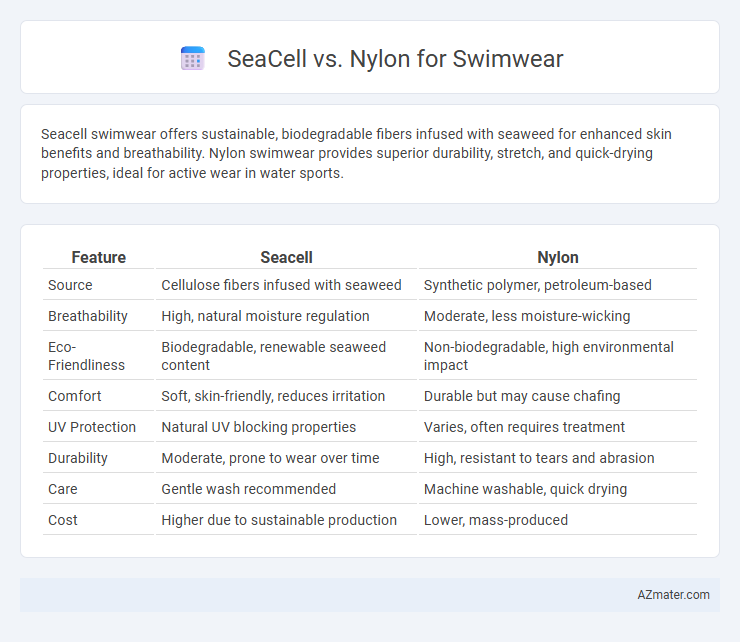Seacell swimwear offers sustainable, biodegradable fibers infused with seaweed for enhanced skin benefits and breathability. Nylon swimwear provides superior durability, stretch, and quick-drying properties, ideal for active wear in water sports.
Table of Comparison
| Feature | Seacell | Nylon |
|---|---|---|
| Source | Cellulose fibers infused with seaweed | Synthetic polymer, petroleum-based |
| Breathability | High, natural moisture regulation | Moderate, less moisture-wicking |
| Eco-Friendliness | Biodegradable, renewable seaweed content | Non-biodegradable, high environmental impact |
| Comfort | Soft, skin-friendly, reduces irritation | Durable but may cause chafing |
| UV Protection | Natural UV blocking properties | Varies, often requires treatment |
| Durability | Moderate, prone to wear over time | High, resistant to tears and abrasion |
| Care | Gentle wash recommended | Machine washable, quick drying |
| Cost | Higher due to sustainable production | Lower, mass-produced |
Understanding Seacell and Nylon: Material Overview
Seacell is an eco-friendly fabric made from cellulose fibers infused with seaweed, offering natural breathability, moisture-wicking properties, and skin-soothing effects ideal for swimwear. Nylon, a synthetic polymer known for its high strength, elasticity, and quick-drying features, provides durable and form-fitting qualities essential for active swimwear use. Understanding these material characteristics helps in choosing swimwear that balances sustainability, comfort, and performance.
Sustainability: Seacell vs Nylon Environmental Impact
Seacell swimwear, derived from sustainably harvested seaweed fibers, offers superior biodegradability and minimal environmental footprint compared to conventional nylon, which is petroleum-based and non-biodegradable. The production of Seacell involves eco-friendly processes that reduce chemical use and water consumption, while nylon manufacturing generates significant greenhouse gas emissions and microplastic pollution. Choosing Seacell over nylon helps mitigate ocean plastic pollution and supports the circular economy in sustainable fashion.
Comfort and Breathability in Swimwear Fabrics
Seacell swimwear fabric offers superior comfort and breathability due to its natural cellulose fibers infused with seaweed extracts, which enhance moisture absorption and skin nourishment. Nylon, while durable and quick-drying, tends to trap heat and moisture, potentially causing discomfort during prolonged wear. Choosing Seacell over Nylon for swimwear provides a softer, more breathable experience ideal for sensitive skin and extended water activities.
Durability and Longevity: Seacell vs Nylon
Seacell fabric, infused with seaweed fibers, offers moderate durability but tends to degrade faster with prolonged exposure to chlorine and saltwater compared to nylon. Nylon swimwear is renowned for its high tensile strength, excellent resistance to abrasion, and superior longevity, maintaining shape and color through repeated wear and wash cycles. For long-term durability and sustained swimwear performance, nylon remains the preferred material over Seacell.
Skin Benefits and Allergen Considerations
Seacell swimwear is infused with seaweed fibers rich in antioxidants and vitamins that promote skin hydration and reduce irritation, making it ideal for sensitive skin. Nylon swimwear, while durable and quick-drying, may cause allergic reactions in individuals prone to synthetic fiber sensitivities. Seacell's natural bioactive properties offer enhanced skin benefits and lower allergen risks compared to the synthetic composition of nylon fabrics.
Water Absorption and Quick-Drying Properties
Seacell fabric offers excellent water absorption due to its natural cellulose fibers combined with seaweed properties, enhancing comfort by retaining moisture without becoming heavy. Nylon, a synthetic fiber, provides superior quick-drying performance because of its low absorbency and ability to wick moisture away from the skin rapidly. Swimwear made from nylon dries faster and is often preferred for activities requiring rapid water release, whereas Seacell swimwear excels in moisture management with a softer, more breathable feel.
UV Protection: Which Material Offers More?
Seacell swimwear provides superior UV protection due to its natural seaweed fibers, which contain antioxidants that help block harmful UV rays, while nylon primarily offers physical barrier protection with less inherent UV-blocking properties. Seacell fabrics often have a higher Ultraviolet Protection Factor (UPF) rating, typically above 50+, making them more effective in preventing sun damage compared to nylon's lower UPF ranges. Nylon is durable and quick-drying but lacks the bioactive compounds that enhance UV protection found in Seacell.
Color Retention and Print Quality Comparison
Seacell swimwear excels in color retention due to its natural cellulose fibers combined with seaweed extracts that enhance dye absorption, resulting in vibrant hues that endure repeated exposure to chlorine and sunlight. Nylon fabric offers strong print quality with sharp, well-defined patterns because of its smooth, synthetic surface, but it tends to fade faster over time under UV exposure and pool chemicals. Choosing Seacell ensures longer-lasting color vibrancy, while Nylon prioritizes initial print sharpness, affecting overall swimwear appearance depending on usage conditions.
Cost and Accessibility for Designers and Consumers
Seacell swimwear, derived from seaweed fibers, often comes at a higher production cost due to its sustainable sourcing and eco-friendly manufacturing processes, making it less accessible for designers aiming for budget-friendly collections. Nylon swimwear, a synthetic material widely available and mass-produced, offers more affordability and accessibility for both designers and consumers seeking durable, cost-effective options. The price difference influences market positioning, with Seacell targeting premium eco-conscious buyers and Nylon appealing to mainstream, price-sensitive customers.
Ideal Uses: Choosing Seacell or Nylon for Your Swimwear
Seacell swimwear is ideal for sensitive skin and eco-conscious consumers due to its natural fibers infused with seaweed, offering breathability and moisture retention. Nylon swimwear excels in durability, stretch, and quick-drying properties, making it perfect for active swimmers and competitive use. Selecting between Seacell and Nylon depends on prioritizing comfort and sustainability versus performance and resilience in water.

Infographic: Seacell vs Nylon for Swimwear
 azmater.com
azmater.com